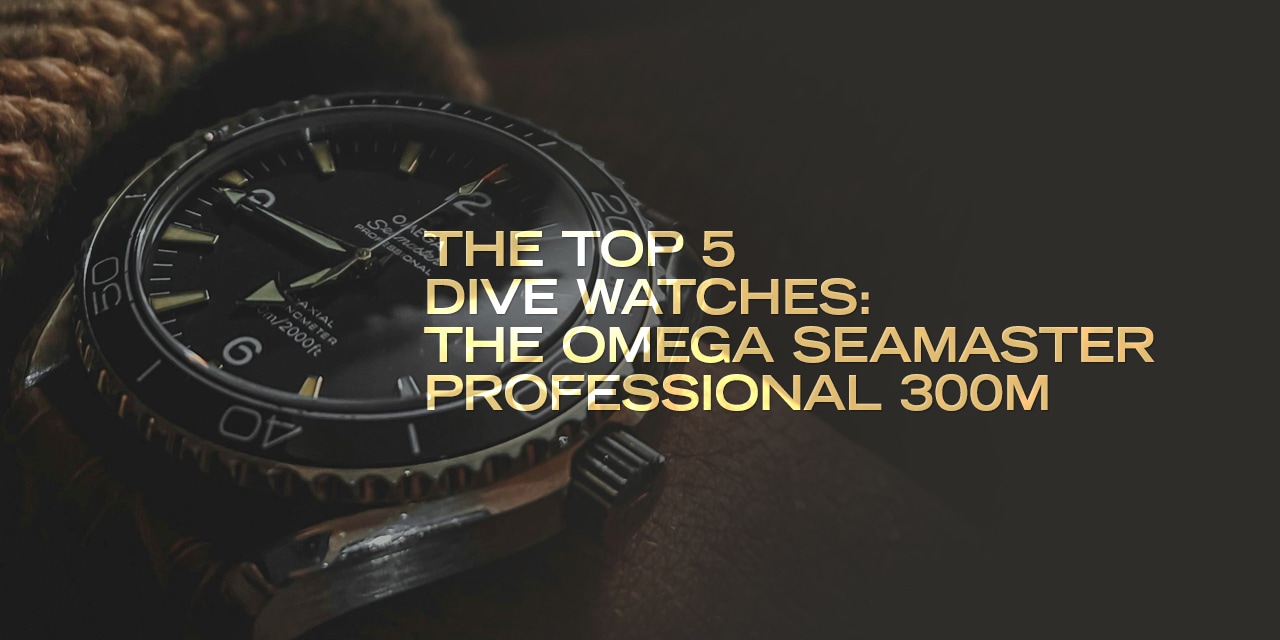The Top 5 Dive Watches: The Omega Seamaster Professional 300M
I saw an interview once with Desmond Llewelyn, the much-missed actor who made the role of 007’s cantankerous quartermaster, Q, his own in a total of 17 Bond films.
In it, he was asked to chime in on that most perennial of questions of which I’m sure he was thoroughly sick; who is the best Bond?
His answer proved more than anything else that he was ever the diplomatist, saying that most people’s favorite was the one they saw first.
It was a good answer and certainly a tactful one. However, in my case at least, it isn’t true. As a fully paid-up Gen Xer, the first Bond I saw was Roger Moore but my favorite (and the best) will always be Sean Connery.
The same criteria might well apply to the watches 007 wore. Over the last 60+ years, he has strapped on a plethora of fantastic pieces, some of which merely told the time, while others came fitted with gadgets which turned out to be almost implausibly appropriate for whatever particular mission he was on.
Yet two of those models stand out as the most iconic, and the one you prefer will, like your personal taste in the actors themselves, tend to hinge on your age.
Old farts like myself and older will probably plump for the Rolex Submariner worn by Connery, Moore and Dalton. Tykes, pipsqueaks and whippersnappers will doubtless gravitate towards the Omega Seamaster Professional 300M first modelled by Pierce Brosnan.
A Little History
The earliest Omega to take the name Seamaster was launched in 1948. The CK2518 was a gentleman’s dress watch with upgraded water resistance, released to commemorate Omega’s 100th birthday.
That was followed in 1957 with the first Seamaster 300 (waterproof to…200m!) making up one third of the legendary Professional Collection which also gave us the original Speedmaster and Railmaster.
After that, Omega lent the Seamaster title to a bewildering number of different models, encompassing everything from massive slabs designed for professional saturation divers like the Ploprof, bizarrely shaped chronographs like the Bullhead, through to short-lived early electronic watches and even some experimental digital/analog hybrid oddities like the Seamaster Chrono-Quartz.
By the start of the 1990s and the tail end of the devastating Quartz Crisis, Omega had tried jumping on just about every bandwagon they could, the upshot being that any watch they came up with for which they could not find a specific home got slapped with the Seamaster label. What the collection needed was a little cohesion.
A Golden Opportunity
In 1993, Omega brought out an all-new Seamaster model.
Technically, it was a follow-up and eventual replacement for the Seamaster 200M, a very ‘80s-styled piece complete with integrated bracelet which came and went relatively unnoticed but which is now, because of the way these things generally pan out, commonly referred to as the ‘Pre-Bond’ Omega.
The new watch, on the other hand, was a hit from the start. Harking back to more traditional designs, the Seamaster Professional 300M, known as the SMP for short, featured the twisted lyre lugs of the not-to-be-confused-with Seamaster 300, along with a bezel with a uniquely scalloped edge and a dial finished with a gently sweeping wave pattern which would come to be a signature of the range. Crucially, it was also water resistant down to 300m, marking it as a true diver’s model, reinforced by the presence of a helium escape valve at the 10 o’clock.
Omega made no secret of the fact they had introduced the SMP to go into direct competition with the Rolex Submariner, still the absolute last word in luxury dive watches.
Whether or not Rolex were at all worried about this in 1993 is unknown (at least by me) but I am willing to bet they became a lot more concerned in 1995 when Omega, and the SMP, achieved the impossible.
The role of James Bond had been vacant since Timothy Dalton’s second and last outing in 1989. But it became common knowledge that a new actor had been found in the shape of Pierce Brosnan and his first movie was imminent.
Oscar-winning costume designer Lindy Hemmings was put in charge of that most vital of Bond considerations, his wardrobe, and it was she who went into bat for Omega. The daughter of a British military officer, Hemmings reasoned that Bond’s background in the Royal Navy would naturally lend itself to him choosing the brand over Rolex, which she described as more ‘for a man of the city’. Arguing in favor of the SMP, Hemmings said, ‘I was convinced that Commander Bond, a naval man, a diver, and a discreet gentleman of the world, would wear this watch’.
Hemmings won her battle and in 1995, Brosnan embarked on his Goldeneye mission sporting a quartz-powered, blue-dialed-and-bezeled Seamaster Professional 300M ref. 2531.80.00. And the rest, as they say, is history.
The handsome watch on its elaborate nine-link bracelet captured viewers imagination’s immediately, its reputation helped on immensely by its starring role in the eponymous video game on the N64, the greatest first person shooter of all time.
The Seamaster 300M Through the Years
That first generation came in a wide variety of styles. As well as the blue model, an all-black piece was also available, and two-tone gold/steel as well as full gold case versions were released. A mechanical variant running on the Caliber 1109 and later the Caliber 1120 supplemented the quartz examples and the SMP was issued as a full-size 41mm along with a mid-size 36mm and a ladies 28mm.
As the collection gained in popularity, a 41.5mm chronograph powered by the Caliber 1164 emerged around 1999, as did both a GMT and a regatta timer. The lume was upgraded from tritium to Luminova in 1997.
In 2006, a new range of movements heralded the arrival of the SMP’s second generation, based around the co-axial Caliber 2500. Dials were upgraded with applied indexes, Omega logo and wording, and the Seamaster text became red.
Strangely, the third generation from 2012 were given smooth glossy dials, doing away with the trademark waves, but the range did gain ceramic bezel inserts in place of the former aluminum.
Finally, the current iteration, making their entrance in 2018 to celebrate 25-years of Omega’s most successful collection to date, brought with them the biggest shakeup so far.
The latest generation have increased in size, ranging from 42mm to 44mm. All benefit from the brand’s own in-house antimagnetic, METAS-certified calibers along with sapphire case backs. These days, both bezel and dial are ceramic, and the latter has had its wave pattern reinstated, laser-engraved for an even sharper finish. Additionally, the bracelet has been modernized as well, with a new extendable foldover clasp and diver’s rack-and-pusher extension system.
There are 46 separate models, including those ever-present limited and special editions, with everything from entry-level steel pieces, watches cast in titanium, tantalum or Sedna gold, all the way through to the top-of-the-line James Bond 60th Anniversary, Canopus gold, silicon dial, diamond-studded bezel model on its stunning mesh bracelet; a snip at $157,800.
The Seamaster Professional 300M was and is an unqualified success story for Omega. The only watch capable of usurping horology’s greatest marketing bonanza away from Rolex, it has proved itself time and time again, with fantasy spies and civilians alike.
A collection at once handsome, varied and extremely capable, it is a worthy winner of the number three spot in our top Dive Watches of All Time list.
Featured Photo: Adil Khan Marwat via Pexels (cc).






